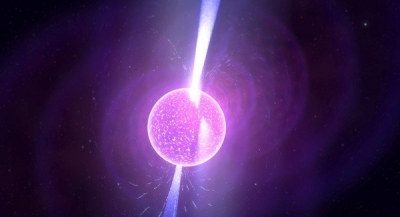
Neutron stars are the smallest and densest stellar objects, excluding black holes and hypothetical white holes, quark stars, and strange stars. Neutron stars have a radius on the order of 10 kilometres (6.2 mi) and a mass of about 1.4 solar masses.
Neutron stars, with a solid crust (and even oceans and an atmosphere!) are the densest solid object we can observe, reaching a few times the density of an atomic nucleus at their core. A sample of neutron star material the size of a grain of sand would weigh roughly the same as the largest ship ever to sail the seas — more than 500,000 tonnes.
Neutron stars also offer a wealth of extreme behaviour which makes them a compelling target for astrophysicists. For the public, however, they seem to suffer from an image problem, lacking the visual appeal of objects that we can image directly, or the otherworldly weirdness of black holes.
Neutron stars comprise one of the possible evolutionary end-points of high mass stars. Once the core of the star has completely burned to iron, energy production stops and the core rapidly collapses, squeezing electrons and protons together to form neutrons and neutrinos. The neutrinos easily escape the contracting core but the neutrons pack closer together until their density is equivalent to that of an atomic nucleus. At this point, the neutrons occupy the smallest space possible (in a similar fashion to the electrons in a white dwarf) and, if the core is less than about 3 solar masses, they exert a pressure which is capable of supporting a star. For masses larger than this, even the pressure of neutrons cannot support the star against gravity and it collapses into a stellar black hole. A star supported by neutron degeneracy pressure is known as a ‘neutron star’, which may be seen as a pulsar if its magnetic field is favourably aligned with its spin axis.
Picture Credit : Google

